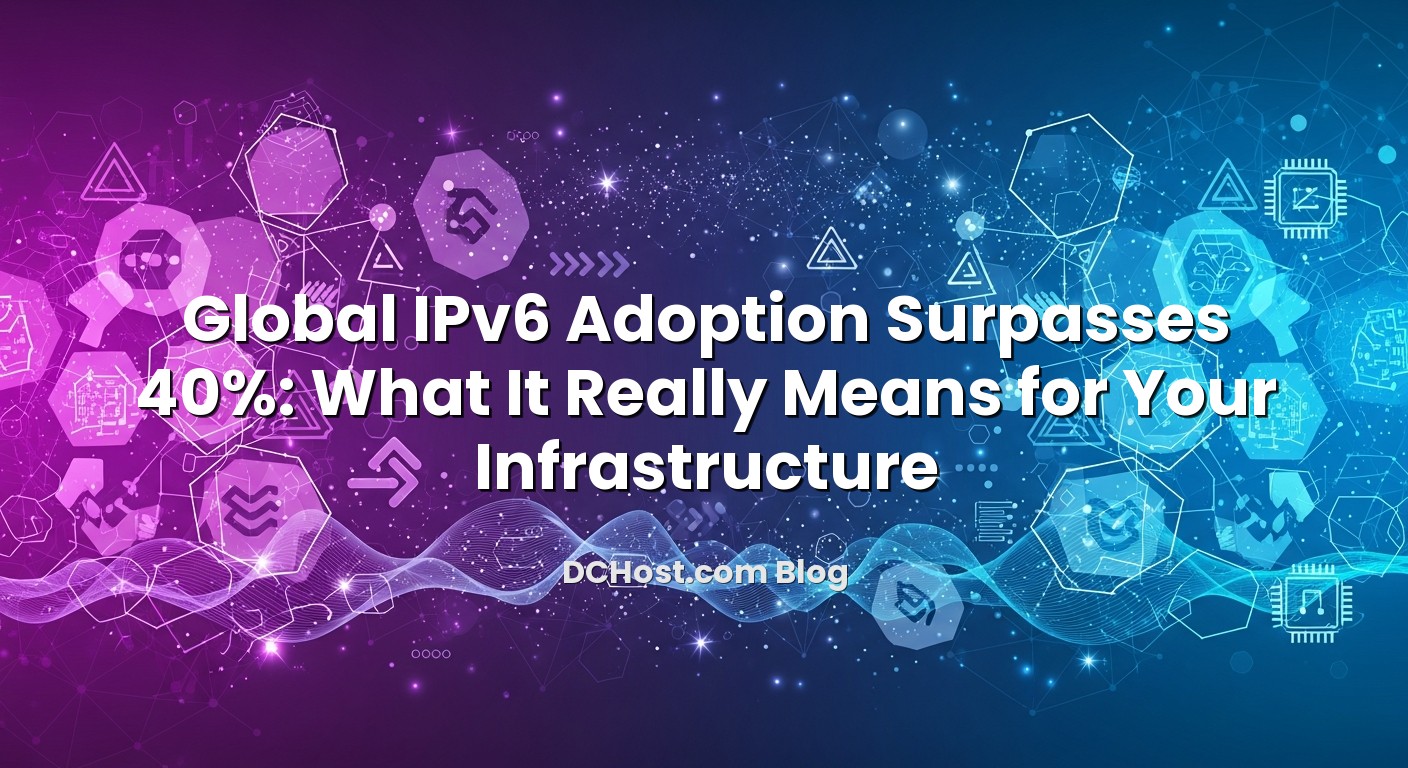Global IPv6 adoption has quietly passed the 40% mark, and this is not just an interesting statistic for network engineers. It is a clear signal that the way we design, host, and scale online services is changing for good. If you run websites, SaaS platforms, APIs, or email infrastructure, this milestone directly affects performance, reliability, and even your cost structure. In planning meetings and architecture reviews with our own customers at dchost.com, IPv6 is no longer an experimental checkbox. It is becoming a default part of capacity planning, security design, and SEO discussions. In this article, we will unpack what “40% adoption” actually means, why it accelerated, and how you can turn this shift into a practical advantage for your business instead of just another item on a never-ending to-do list.
İçindekiler
- 1 What Does “Global IPv6 Adoption Above 40%” Actually Mean?
- 2 Why IPv6 Adoption Is Accelerating Right Now
- 3 What This Milestone Changes for Site and App Owners
- 4 A Practical Roadmap: Turning 40%+ IPv6 Adoption into an Advantage
- 5 Operational Gotchas and How We Deal With Them
- 6 Beyond Dual-Stack: The Rise of IPv6-Only Segments
- 7 Where We Go from Here
What Does “Global IPv6 Adoption Above 40%” Actually Mean?
When you read that global IPv6 adoption has crossed 40%, it is natural to ask: 40% of what, exactly? Different organizations measure adoption slightly differently, but they all point to the same trend: a rapidly growing share of real-world users can reach your services over IPv6.
Users vs. Traffic vs. Networks
There are three main angles to this number:
- End users: Large content networks and measurement platforms track which protocol visitors use when connecting. Over 40% of users worldwide now reach them primarily over IPv6 when it is available.
- Traffic share: In many countries, especially where mobile networks are strong, the share of actual traffic volume over IPv6 is already well beyond 40% and still rising.
- Networks and ASNs: A growing percentage of ISPs, mobile operators, and enterprise networks now announce IPv6 prefixes and route IPv6 end-to-end.
So that 40% is not a theoretical deployment metric. It means a large portion of your visitors can and will prefer IPv6 if your hosting setup supports it.
Regional and Mobile Differences
IPv6 adoption is not uniform across the globe:
- Some countries have adoption rates above 60–70%, often driven by mobile operators that designed newer networks as IPv6-first.
- Other regions are still below 20%, typically where legacy infrastructure and cheap IPv4 sharing (CGNAT) are heavily used.
- On mobile networks, IPv6 adoption is usually higher than on fixed broadband, because NAT exhaustion hit mobile providers earlier and harder.
For you, this means your real IPv6 share will depend on your audience. A site serving tech-savvy users and mobile-heavy traffic might already see more IPv6 than the global average. A regional B2B portal in a lagging market might still be mostly IPv4 today, but that can change quickly as ISPs roll out new access networks.
Why IPv4 Exhaustion Is the Silent Driver
IPv6 adoption figures only make sense when you look at the other side of the story: IPv4 exhaustion and price pressure. We have already discussed in detail where all the IPv4 went and why prices keep rising, and the trend has not reversed. Address scarcity and expensive LIR/transfer markets make it increasingly unattractive to stay IPv4-only for new networks and services.
For hosting providers like us, this reality is felt in day-to-day planning: every IPv4 address must be justified, reused, or carefully allocated. IPv6, by contrast, gives you enough address space to design cleaner, more scalable networks without constant renumbering or complex NAT topologies.
Why IPv6 Adoption Is Accelerating Right Now
Crossing 40% is not a random milestone; it is the outcome of several trends that finally aligned.
1. IPv4 Prices and CGNAT Pain Have Become Too Visible
As IPv4 prices hit record highs, many operators responded with heavy use of Carrier-Grade NAT (CGNAT). While CGNAT makes IPv4 last a bit longer, it also:
- breaks some peer-to-peer and gaming use cases,
- complicates geolocation and logging,
- and increases latency and operational complexity.
For a growing number of ISPs, it is now simpler and cheaper to deploy IPv6 end-to-end and treat IPv4 as a compatibility layer, instead of the other way round. This mirrors the strategy we advocate to our customers: prioritize IPv6 where possible, let IPv4 follow.
2. Major Content and Hosting Ecosystems Turned IPv6 On by Default
Once big content platforms, CDNs, and modern hosting providers started enabling IPv6 by default, the adoption flywheel accelerated. Users whose ISPs support IPv6 automatically began connecting over the new protocol without changing anything on their devices.
On our side at dchost.com, IPv6 support is baked into how we design networks for shared hosting, VPS, and dedicated servers. When customers see that enabling an AAAA record and adjusting a firewall rule is often all it takes to go dual-stack, they are much more willing to move.
3. Operational Knowledge and Tooling Have Matured
Ten years ago, many teams were understandably cautious: IPv6 felt exotic, diagnostic tools were unfamiliar, and documentation was thin. That has changed. We now have solid real-world playbooks, monitoring, and security practices. In our own work we have documented how to accelerate IPv6 adoption without drama, precisely because so many earlier fears did not materialize when you plan carefully.
4. Governments and Enterprises Are Setting Deadlines
In some regions, governments now mandate IPv6 for public sector services or new infrastructure tenders. Large enterprises add IPv6 readiness to vendor checklists. For hosting customers, this often shows up as a short line in a requirements document that suddenly becomes urgent: “Service must be accessible over IPv6.” With global adoption above 40%, such requirements are no longer seen as futuristic; they are just part of being reachable to the modern internet.
What This Milestone Changes for Site and App Owners
So IPv6 adoption is over 40%. What does that really change if you run websites, e‑commerce, SaaS, APIs, or email on our infrastructure?
Your IPv4‑Only Site Is Now Actively Leaving Performance on the Table
When both IPv4 and IPv6 are available, modern systems use a mechanism called “Happy Eyeballs” to choose the faster path. For a significant portion of users, the IPv6 path is shorter, with fewer NAT layers and middleboxes. That can translate to:
- slightly better latency (and thus TTFB),
- more predictable routing under congestion,
- and fewer brittle dependencies on overloaded CGNAT gateways.
We have already written about how low latency and consistent TTFB impact Core Web Vitals in our guide on Core Web Vitals and hosting infrastructure choices. Enabling IPv6 is one of those small, structural decisions that support that improvement instead of fighting it.
Reliability: One More Path Around Partial Outages
Imagine a regional ISP misconfigures part of their IPv4 routing, or a CGNAT cluster misbehaves under load. If the same ISP has functional IPv6 paths, dual-stack users can still reach your service over IPv6 even while IPv4 is degraded. The reverse is also true: if an IPv6 route flaps, IPv4 can carry the load.
With 40%+ of users able to use IPv6, dual-stack hosting becomes a simple form of path redundancy. It is not the same as full multi-region failover, but it can help soften the edges of real-world network issues.
SEO and Reach: Not a Direct Ranking Factor, but a Real Signal
Search engines do not explicitly say “sites with IPv6 rank higher,” but they do care deeply about:
- fast, consistent page loads,
- global reach to mobile users,
- and absence of random connectivity issues.
In some markets, mobile networks are effectively IPv6-first. If your site is only available over IPv4, users might reach you via NATed IPv4 gateways that are slower or less reliable than native IPv6 paths. Over time, this can influence bounce rates and engagement metrics that search engines watch closely.
Cost and Address Strategy: IPv6 as the Growth Layer
With IPv4 addresses expensive and scarce, many businesses are now treating IPv4 as a compatibility layer and IPv6 as the default for growth. That means:
- New services and microservices are designed IPv6-first inside the data center.
- IPv4 is carefully reserved for external-facing endpoints that absolutely need it.
- Internal communication, backups, monitoring, and east–west traffic rely on plentiful IPv6 space.
If you want a deeper dive into the economics of this shift, our article on record-high IPv4 address prices and strategies to adapt explains why it is risky to keep scaling on IPv4 alone.
A Practical Roadmap: Turning 40%+ IPv6 Adoption into an Advantage
Knowing that IPv6 is “important” is not enough. Let’s walk through a step-by-step, realistic roadmap we often apply with dchost.com customers who want to move forward without drama.
Step 1: Inventory What You Actually Run
Start with a simple list:
- Which domains do you own (including staging, internal dashboards, APIs)?
- Where are their DNS records managed?
- Which servers and services do they point to (shared hosting, VPS, dedicated, load balancers)?
- What email infrastructure (MX, SPF, DKIM, DMARC) do you use?
This inventory is essential. You do not want to enable IPv6 only on half the stack and forget a management panel, an internal API, or a critical webhook endpoint.
Step 2: Check Your Hosting and Network IPv6 Readiness
On each environment (shared hosting account, VPS, dedicated server, or colocated hardware), verify:
- Is an IPv6 address already assigned or easily assignable?
- Is the OS and network stack configured for IPv6 (kernel, sysctl, routing)?
- Are your firewall rules (iptables, nftables, cloud firewalls) mirrored for IPv6?
- Does your web server (Nginx, Apache, LiteSpeed, etc.) listen on IPv6?
On our platforms, we routinely provision VPS and dedicated servers with both IPv4 and IPv6, so this step is usually about confirming configuration rather than hunting for missing features.
Step 3: Enable Dual-Stack on Web and API Endpoints
For public-facing sites and APIs, the safest path is nearly always dual-stack: support both IPv4 and IPv6 at the same time. That means:
- Assigning an IPv6 address to your server or load balancer interface.
- Updating your web server to listen on both protocols.
- Adding AAAA records in DNS for the relevant hostnames.
- Ensuring SSL/TLS certificates cover these names (the protocol does not change the certificate requirements).
We already wrote a detailed, practical dual-stack checklist in our article “Ready for IPv6? My No-Drama Dual-Stack Playbook for AAAA Records and Real-World Tests”. If you prefer a step-by-step guide with real-world commands and test flows, that is a great next read after this high-level overview.
Step 4: Test from Multiple Networks and Locations
After enabling IPv6, test connectivity from:
- a mobile network that supports IPv6,
- a fixed broadband connection with IPv6,
- and IPv4-only networks (to confirm nothing broke).
Use tools like ping6, traceroute6, browser dev tools, and online IPv6 checkers. In addition, monitor logs on your web server and WAF to confirm that real traffic is arriving over IPv6 and behaves as expected.
Step 5: Extend IPv6 to Email, Admin Panels, and Internal Services
Once your public sites are stable on dual-stack, extend IPv6 to:
- Mail servers (MX records, HELO/EHLO names, PTR/rDNS),
- control panels (cPanel, Plesk, custom dashboards),
- APIs used by mobile apps or integrations,
- monitoring and logging endpoints.
Email over IPv6 has its own nuances around PTR, SPF, and blocklists. We covered these in depth in our playbook for email deliverability over IPv6, including what to watch out for with anti-spam systems and reputation.
Operational Gotchas and How We Deal With Them
With 40%+ of the world reachable over IPv6, the question is no longer “Should I deploy IPv6?” but “How do I run it reliably?” Here are the main pitfalls we see, and how we approach them in real environments.
Security: Don’t Forget to Mirror Policies to IPv6
One of the most common issues is enabling IPv6 on an interface but forgetting to:
- add corresponding firewall rules,
- apply rate limits and WAF rules to IPv6 traffic,
- or tune intrusion detection systems to inspect IPv6.
Because IPv6 subnets are huge, naive “allow everything” strategies can be risky. The best approach is to mirror your existing IPv4 security posture: the same ports, same policies, same logging, just on a different protocol. On our managed environments, we treat IPv6 as a first-class citizen in security templates from day one.
Monitoring and Logging: See Both Protocols Clearly
If your metrics platform or log parsers only group traffic by IPv4, you may underestimate your true load or miss IPv6-specific patterns. Make sure:
- access logs include full IPv6 addresses,
- dashboards separate and aggregate IPv4/IPv6 where useful,
- alerts fire based on total traffic, not just IPv4 counters.
This is especially important when planning capacity upgrades for your VPS or dedicated servers. We often see graphs where IPv4 traffic looks flat while total (IPv4+IPv6) volume has grown significantly.
Email Deliverability: Extra Checks for IPv6 Senders
Some receiving systems are more conservative about accepting mail from IPv6 senders, especially if DNS and authentication are not perfectly configured. To avoid problems:
- Set correct PTR/rDNS for IPv6 addresses used by mail servers.
- Ensure SPF records mention IPv6 addresses or include mechanisms that do.
- Monitor blocklists and feedback loops for IPv6 ranges, just as you do for IPv4.
Our detailed guide on email deliverability over IPv6 walks through these requirements with concrete examples and troubleshooting tips.
Application Code and Hard-Coded Assumptions
Modern frameworks generally handle IPv6 without issue, but legacy code sometimes makes assumptions like:
- IP addresses always fit in 15 characters,
- log lines never contain colons in IP fields,
- or database columns for IPs are too narrow.
As you deploy IPv6 and start seeing real traffic, keep an eye on logs and error reports. If you have custom access-control lists or whitelists by IP, check that they work with IPv6 CIDR notation.
Beyond Dual-Stack: The Rise of IPv6-Only Segments
With global adoption rising, more operators are experimenting with IPv6-only subnets and using translation for legacy IPv4 access. This is not just theory; we have already explored it hands-on in our article about running a website on an IPv6-only VPS with NAT64/DNS64 bridges to IPv4.
Why IPv6-Only Is Appealing in the Data Center
Inside data centers and private networks, IPv6-only designs can bring real benefits:
- simpler address management with huge, structured subnets,
- no overlapping RFC1918 ranges between tenants or projects,
- cleaner security segmentation using IPv6 prefixes,
- and reduced dependence on complex NAT rules.
External access to IPv4-only services can then be handled via NAT64, HTTP proxies, or dual-stack edge nodes. As IPv6 user adoption climbs from 40% toward 60% and beyond, these models will become increasingly common.
What This Means for New Projects Today
If you are starting a new project in 2025, the safest strategy is:
- Design internal components as IPv6-first (or IPv6-only) where practical.
- Expose public endpoints as dual-stack so all clients can reach you.
- Plan for a gradual reduction in IPv4 dependency over the next 5–10 years.
We have already seen teams regret not enabling IPv6 from the start, especially when they later needed to support regions where IPv6 is dominant. Retrofitting IPv6 into a complex architecture under time pressure is far less pleasant than building it in from day one.
Where We Go from Here
Crossing the 40% global IPv6 adoption mark is less like a finish line and more like the halfway point of a long migration. In previous years, asking for IPv6 support felt like an optional “nice to have”. Now, with real user traffic shifting at scale, IPv6 has become a practical requirement for serious online services.
At dchost.com, we see this change reflected in customer conversations every week: from domain registration and DNS planning to selecting VPS or dedicated server configurations that are ready for dual-stack or even IPv6-first deployments. If you are unsure where you stand today, start with a simple check: do your main domains have working AAAA records pointing to IPv6-enabled servers? If not, this is the right moment to catch up while the world is still in the dual-stack phase.
If you want help planning your own IPv6 roadmap – whether that is enabling dual-stack on existing sites, designing IPv6-aware email infrastructure, or experimenting with IPv6-only segments – our team can share the same practical playbooks we use internally and in articles like why IPv6 adoption is suddenly everywhere. The 40% milestone is your signal: this is no longer an experiment. It is the next normal for hosting, networks, and the open internet.





